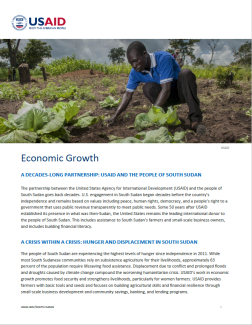BUILDING FINANCIAL RESILIENCE
South Sudan’s economy is mired in a web of challenges that debilitate economic growth. Widespread corruption and an absence of political will to use public resources for public good significantly hinder South Sudan’s prospects for sustainable economic growth. While most of South Sudan’s public revenue is spent on roads, South Sudanese have yet to benefit from this investment. With nearly 500 kilometers, or about 310 miles, of paved roads, South Sudan has the lowest level of rural accessibility to road networks in the world; about one quarter of the rural population has access to an all-season road and many roads are rendered impassable or difficult to travel on during the rainy season. Similarly, the transitional government’s failure to transparently allocate funds for public sector salaries, the health sector, and expanding humanitarian needs stifles potential benefits to the people. The transitional government must demonstrate political will to meet its peace commitments, establish accountability for human rights violations, and take measures against corruption before responsible private investment and economic growth can flourish. The transitional government must also more effectively manage national income from oil—which accounts for about 98 percent of government revenue and continues to be siphoned off to political elites—and substantially increase its financial contributions to support basic human needs.
Despite these significant economic challenges, USAID is building financial literacy in some of South Sudan’s most remote communities by laying the groundwork for families to earn and save money. Through USAID’s Village Savings and Loan Associations, more than 3,000 people across nine counties have saved more than $13,550 and loaned nearly $2,150 since 2021, giving community members the financial means to start small at-home businesses and purchase farming equipment to grow food. To help build small-scale private sector activities, USAID provides resources to women and youth in Western Equatoria and Lakes States to produce, process, and sell honey and shea butter. This spurs small business development, creates jobs for youth, reduces conflict over limited resources, and generates income, including for producers, processors, and exporters.
BUILDING FARMERS’ AGRICULTURAL SKILLS AND STRENGTHENING LIVELIHOODS
Up to 95 percent of South Sudanese depend on subsistence farming, fishing, or herding for food and income, according to the UN Food and Agriculture Organization; yet, South Sudan faces one of the worst humanitarian and food security crises in the world. An estimated 9 million South Sudanese—or about 75 percent of the population—are food insecure, facing crisis levels of hunger, and will need humanitarian assistance in 2024. Further, poor nutrition, combined with disease, unsanitary conditions, and limited access to basic services, exacerbates already-high malnutrition rates. International observers estimate that nearly 2.2 million people, including 1.4 million children and 740,000 pregnant and lactating women, could soon face acute malnutrition. Making matters worse for South Sudanese families, the cost of fuel increased by more than 79 percent and food basket prices more than doubled nationwide between June 2022 and June 2023, according to the UN World Food Program. The crisis in Sudan which shutdown supply lines into South Sudan has further increased the cost of consumer goods.
USAID’s economic growth portfolio aims to transition South Sudanese out of humanitarian assistance towards more sustainable livelihoods in more secure areas of the country. Our work helps farmers grow food and increase their income—including through production and distribution of honey and shea butter products—while reducing local conflict through economic cooperation. Since 2021, nearly 30,000 South Sudanese, more than half of whom are women and nearly 80 percent between 15 and 29, have participated in USAID economic growth activities. Since then, USAID assistance has provided nearly 13,000 farmers with machinery and climate-resistant seeds, improved nutrition for nearly 2,500 children under-five, spurred more than $1 million in agricultural sales, and helped communities cultivate nearly 8,000 hectares of land—that’s just over 11,200 soccer pitches.

